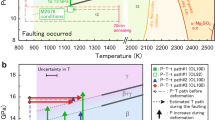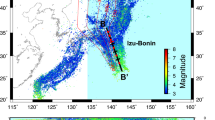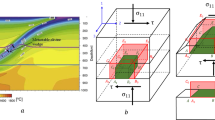Abstract
RECENT experimental work on silicate olivine polymorphs1 has confirmed earlier observations of mechanical failure in analogous compounds2,3 as a result of phase transformations when non-hydrostatic stresses were applied to a metastable phase. This 'transformational faulting'4 mechanism is considered to be a leading candidate5, among others involving olivine transformation6,7, for the cause of deep earthquakes. Evidence consistent with this mechanism comes from the observation2–4 that, worldwide, earthquakes become more numerous with increasing depth after a seismicity minimum at about 350 km depth8. This depth lies within the range anticipated for mineralogical transformations in the subducted lithosphere9. But individual subduction zones differ in their thermal structures, so if transformational faulting indeed contributes to deep seismicity, this should be reflected in the location of the seismicity minimum for each zone. The depth at which the minimum occurs should depend on temperature in the same way as do the polymorphic transformations of olivine, and should always lie deeper than the depth at which the equilibrium transformation takes place. Here we test these predictions for eight subduction zones worldwide. We find that, with one exception (the North Japan zone), the depth of the seismicity minimum decreases linearly with increasing thermal age of the slab (a measure of its temperature profile). These results support the proposal that deep earthquakes are a consequence of phase transformations in olivine.
This is a preview of subscription content, access via your institution
Access options
Subscribe to this journal
Receive 51 print issues and online access
$199.00 per year
only $3.90 per issue
Buy this article
- Purchase on Springer Link
- Instant access to full article PDF
Prices may be subject to local taxes which are calculated during checkout
Similar content being viewed by others
References
Green, H. W., Young, T. E., Walker, D., Scholz, C. & Prior, D. Trans. Am. Geophys. Un. 71, 946 (1990).
Kirby, S. H. J. geophys. Res. 92, 13789–13800 (1987).
Green, H. W. & Burnley, P. C. Nature 341, 733–737 (1989).
Kirby, S. H., Durham, W. B. & Stern, L. A. Science 252, 216–225 (1991).
Kirby, S. H. Trans. Am. Geophys. Un. 71, 946 (1990).
Rubie, D. C. Nature 308, 505–508 (1984).
Lomnitz-Adler, J. J. Phys. Earth 38, 83–98 (1990).
Frohlich, C. Ann. Rev. Earth planet. Sci. 17, 227–254 (1989).
Akaogi, M., Ito, E. & Navrotsky, A. J. geophys. Res. 94, 15671–15685 (1989).
Brodholt, J. & Stein, S. Geophys. Res. Lett. 15, 1081–1084 (1988).
Vassiliou, M. S., Hager, B. H. & Raefsky, A., J. Geodynam. 1, 11–28 (1984).
Wortel, R. Nature 296, 553–556 (1982).
Wortel, R. Geophys. Res. Lett. 13, 34–37 (1986).
Wortel, R. & Vlaar, N. J. Pure appl. Geophys. 128, 625–659 (1988).
Meade, C. & Jeanloz, R. Science 252, 68–72 (1991).
Bina, C. R. & Wood, B. J. J. geophys. Res. 92, 4853–4866 (1987).
Molnar, P., Freedman, C. & Shin, J. F. Geophys. J. R. astr. Soc. 56, 41–54 (1979).
Larson, R. L. et al. The Bedrock Geology of the World (map) (Freeman, New York, 1985).
Leg 129 shipboard scientific party Nature 345, 112 (1990).
Jarrard, R. D. Rev. Geophys. 24, 217–284 (1986).
Toksöz, M. N., Sleep, N. H. & Smith, A. T. Geophys. J. R. astr. Soc. 35, 285–310 (1973).
DeMets, C., Gordon, R. G., Argus, D. F. & Stein, S. Geophys. J. Int. 101, 425–478 (1990).
Geller, R. J. Bull. seism. Soc. Am. 66, 1501–1523 (1976).
Press, W. H., Flannery, B. P., Teukolsky, S. A. & Vetterling, W. T. Numerical Recipes (Cambridge University Press, 1987).
Author information
Authors and Affiliations
Rights and permissions
About this article
Cite this article
Helffrich, G., Brodholt, J. Relationship of deep seismicity to the thermal structure of subducted lithosphere. Nature 353, 252–255 (1991). https://doi.org/10.1038/353252a0
Received:
Accepted:
Issue Date:
DOI: https://doi.org/10.1038/353252a0
This article is cited by
-
2-D elastic FEM simulation on stress state in the deep part of a subducted slab
Acta Seismologica Sinica (2002)
-
2-D viscoelastic FEM simulation on stress state in the deep part of a subducted slab
Acta Seismologica Sinica (2002)
-
NW Pacific slab rheology, the seismicity cutoff, and the olivine to spinel phase change
Earth, Planets and Space (1998)
-
Metastability of enstatite in deep subducting lithosphere
Nature (1994)
-
Evidence for transformational faulting from a deep double seismic zone in Tonga
Nature (1993)
Comments
By submitting a comment you agree to abide by our Terms and Community Guidelines. If you find something abusive or that does not comply with our terms or guidelines please flag it as inappropriate.



